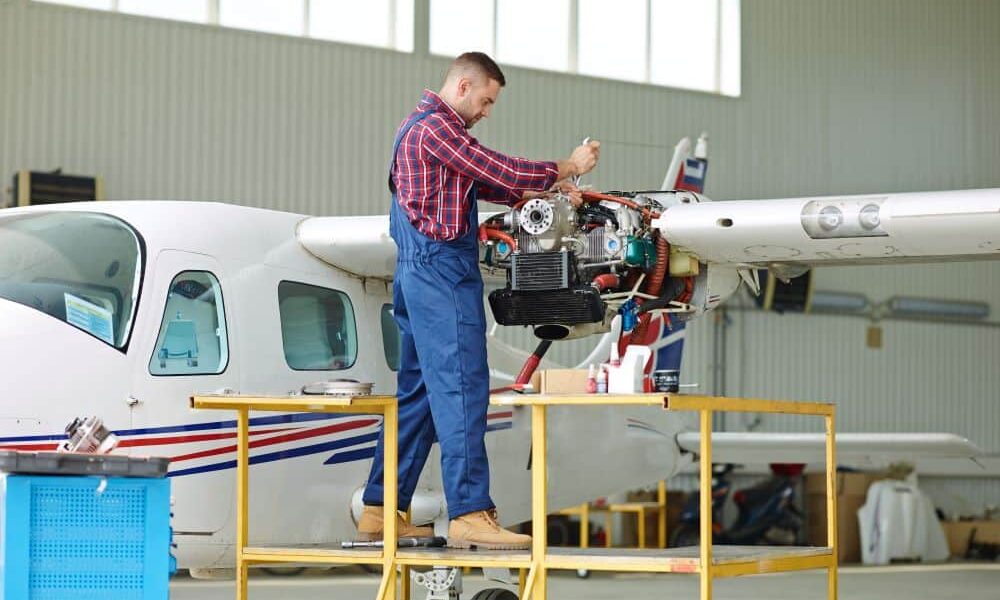How much should I budget for maintenance and repairs on my light aircraft?

Introduction
Aviation enthusiasts and pilots alike understand the exhilaration and freedom that comes with owning a light aircraft. However, amidst the thrill of taking to the skies, one must not overlook the crucial aspect of budgeting for maintenance and repairs.
The upkeep of a light aircraft is essential not only for ensuring its airworthiness but also for safeguarding the pilot’s safety and the longevity of the aircraft itself. This article aims to delve into the intricacies of budgeting for maintenance and repairs on a light aircraft, providing valuable insights into why this financial planning is indispensable in aviation.
Importance of Budgeting for Maintenance and Repairs on a Light Aircraft
Budgeting for maintenance and repairs on a light aircraft is more than just financial planning; it is a fundamental responsibility that every aircraft owner must undertake. Regular maintenance is vital to keep an aircraft in optimal condition, ensuring that all components are functioning correctly and minimizing the risk of mechanical failures during flight. By setting aside funds specifically designated for maintenance and repairs, owners can proactively address any issues that may arise, thereby enhancing safety levels and operational efficiency.
Overview of Factors Influencing Costs
Numerous factors come into play when determining the costs associated with maintaining and repairing a light aircraft. The age of the aircraft plays a significant role, as older planes may require more frequent inspections and replacements due to wear and tear. Additionally, usage patterns impact costs; an aircraft used frequently will likely incur higher maintenance expenses than one flown infrequently.
The type of aircraft also influences costs; complex systems or specialized components may require more extensive servicing, resulting in increased expenditures. It is essential for owners to consider these factors when crafting their budget for maintenance and repairs on their light aircraft.
High-Level Overview of Maintenance and Repair Costs
Average Annual Costs for Light Aircraft Maintenance and Repairs
When it comes to budgeting for maintenance and repairs on a light aircraft, understanding the average annual costs is crucial. On average, light aircraft owners can expect to spend anywhere from $1,500 to $3,000 per year on maintenance and repairs.
This includes routine inspections, servicing, and minor repairs that are essential for ensuring the airworthiness of the aircraft. However, it is important to note that these are just rough estimates and actual costs can vary significantly based on several factors.
Factors Affecting Costs
The costs associated with maintaining and repairing a light aircraft can be influenced by various factors. One key factor is the age of the aircraft. Older aircraft tend to require more frequent maintenance and may have components that are more prone to wear and tear, leading to higher repair costs.
Additionally, the usage of the aircraft plays a significant role in determining maintenance costs. Aircraft that are flown frequently or used for commercial purposes will incur higher maintenance expenses compared to those used recreationally.
Another factor that impacts maintenance and repair costs is the type of aircraft itself. Different types of light aircraft have varying levels of complexity in terms of their systems and components.
For example, a complex high-performance single-engine aircraft may require more specialized maintenance procedures and parts compared to a basic two-seater training plane. Understanding these factors is essential for accurately budgeting for maintenance and repair expenses related to your specific type of light aircraft.
Routine Inspections and Servicing
The Vital Importance of Routine Inspections
Routine inspections are the backbone of ensuring the airworthiness and safety of your light aircraft. These scheduled check-ups play a crucial role in detecting any potential issues or wear and tear before they escalate into major problems.
The frequency of routine inspections varies depending on factors such as the type of aircraft, its age, and how often it is flown. Typically, light aircraft owners should budget for annual inspections to guarantee that their aircraft remains in optimal condition.
Frequency and Cost Estimates for Routine Inspections
The cost of routine inspections can vary based on the complexity of the inspection required and the hourly rates charged by maintenance facilities. On average, a routine annual inspection for a light aircraft can range from $800 to $1,500.
More extensive inspections, such as 100-hour inspections or phase inspections, may cost considerably more due to the additional checks involved. It’s essential for owners to factor in these costs when budgeting for maintenance expenses to ensure that their aircraft receives proper care without breaking the bank.
The Preventative Power of Regular Servicing
Regular servicing is not just about ticking boxes on a checklist; it is about safeguarding your investment and prioritizing safety above all else. By adhering to scheduled servicing intervals recommended by the manufacturer or aviation authority, you not only prolong the lifespan of your aircraft but also minimize the risk of costly repairs down the line. Investing in regular servicing is akin to giving your aircraft a wellness check-up – it identifies minor issues early on and addresses them promptly before they evolve into major headaches.
Engine Maintenance
The Heartbeat of Your Aircraft: Engine Maintenance Fundamentals
Engines are undoubtedly one of the most critical components of any aircraft, dictating its performance and reliability. When it comes to budgeting for maintenance costs, engine maintenance should be a top priority due to its impact on overall safety and operational efficiency. Engine overhauls or replacements are significant undertakings that require meticulous attention to detail and skilled labor.
Cost Considerations for Engine Overhauls or Replacements
The costs associated with engine overhauls or replacements can vary widely depending on factors such as the type of engine installed in your aircraft and its total hours flown. On average, an engine overhaul for a light aircraft can cost anywhere from $20,000 to $40,000 or more, while full engine replacements could exceed $60,000 depending on complexity. These figures serve as a sobering reminder that neglecting regular engine maintenance can lead to substantial financial repercussions down the line.
Factors Influencing Engine Maintenance Costs
Several factors influence engine maintenance costs beyond just the type of engine and hours flown. The operational environment in which your aircraft operates plays a significant role – harsh conditions or frequent short-haul flights can accelerate wear and tear on engines.
Additionally, proactive measures such as adhering to proper operating procedures outlined in your owner’s manual can help mitigate unexpected failures that could result in costly repairs. By understanding these influencing factors upfront, owners can make informed decisions regarding their engine maintenance budgets while prioritizing safety above all else.
Repair Costs
Landing Gear Repairs: Ensuring Safe Landings
Landing gear repairs are crucial for maintaining the safety and functionality of a light aircraft. Common issues with landing gear include worn tires, damaged struts, or malfunctioning hydraulic systems. The cost of landing gear repairs can vary widely depending on the extent of the damage and whether any components need to be replaced.
Minor repairs such as tire replacements may cost a few hundred dollars, while more extensive repairs like strut replacements could run into the thousands. It is essential to address landing gear issues promptly to avoid compromising the safety of takeoffs and landings.
Avionics Repairs: Keeping Communication Clear
Avionics repairs involve fixing any electronic systems within the aircraft, including communication and navigation equipment. Avionics play a critical role in ensuring clear communication with air traffic control and other aircraft, as well as providing accurate navigational data. Common avionics issues can include faulty radios, malfunctioning transponders, or inaccurate GPS systems.
Repair costs for avionics can vary widely depending on the specific component that needs attention. Simple fixes like software updates may be relatively inexpensive, while replacing a complex avionics unit could cost several thousand dollars.
Wing and Fuselage Repairs: Structural Integrity Matters
Wing and fuselage repairs are essential for maintaining the structural integrity of a light aircraft. Damage to wings or fuselage can compromise aerodynamic performance and overall safety during flight. Common types of wing and fuselage repairs include patching up dents or cracks, replacing damaged panels, or repairing corrosion.
The cost of these repairs can range from minor cosmetic touch-ups to major structural reconstruction, with prices varying based on the severity of the damage. It is crucial to address any wing or fuselage issues promptly to prevent further deterioration and ensure the continued airworthiness of your aircraft.
Specialized Inspections: Propeller Balancing and Dynamic Balancing
Propeller balancing is a critical aspect of maintaining the optimal performance and safety of your light aircraft. A balanced propeller ensures smooth operation, reduces vibration, and minimizes wear and tear on the engine components. During propeller balancing, each blade’s weight distribution is carefully adjusted to ensure that they all exert an equal amount of force, leading to improved efficiency and performance.
This process is typically done using precision equipment by experienced aviation mechanics who specialize in propeller maintenance. Dynamic balancing goes a step further by considering the entire rotating system’s balance, including the propeller, crankshaft, and other rotating components.
This comprehensive approach helps identify any imbalances that may not be apparent during regular inspections. Dynamic balancing can detect issues such as misaligned engines or worn-out components that could lead to costly repairs or even catastrophic failures if left unchecked.
Investing in regular dynamic balancing can prolong your aircraft’s lifespan and enhance its overall safety during flight. Ensuring your aircraft undergoes both propeller balancing and dynamic balancing at recommended intervals is crucial for maintaining its airworthiness and performance standards.
Neglecting these specialized inspections can result in increased vibration levels, decreased fuel efficiency, and potential structural damage over time. By prioritizing these maintenance procedures, you not only enhance the safety of your flights but also protect your investment by extending the longevity of critical components like the engine and propeller system.
The Significance of Avionics Updates for Enhanced Safety
Avionics technology plays a pivotal role in modernizing light aircraft systems for improved navigation, communication, and situational awareness capabilities. Regular avionics updates are essential for ensuring that your aircraft remains equipped with the latest advancements in technology to enhance safety during flights. Upgrading avionics systems can provide features such as GPS navigation, weather radar integration, terrain awareness warnings, traffic collision avoidance systems (TCAS), and autopilot functionalities that contribute to a safer flying experience.
Avionics updates not only enhance safety but also improve operational efficiency by streamlining cockpit instrumentation and data management processes. Advanced avionics systems offer pilots real-time information on weather patterns, traffic conditions, airspace restrictions, and nearby airports—empowering them to make informed decisions quickly during flights.
Additionally, updated avionics are often more user-friendly with intuitive interfaces that reduce pilot workload and increase overall flight comfort while optimizing performance metrics. By embracing avionics updates as a proactive maintenance strategy for your light aircraft, you demonstrate a commitment to enhancing flight safety standards while staying abreast of technological advancements in aviation.
Regularly updating your avionics suite ensures compliance with evolving regulations and industry standards while equipping you with cutting-edge tools to navigate diverse flying environments confidently. Prioritizing avionics upgrades underscores your dedication to continuous improvement in both operational efficiency and safety outcomes for every flight you undertake.
Budgeting Strategies
Creating a realistic budget for maintenance and repairs on your light aircraft is crucial to ensuring its safety and airworthiness. To start, it is essential to understand the typical costs associated with routine maintenance, inspections, and potential repairs based on the make and model of your aircraft.
Researching industry averages for these costs can provide a baseline for budgeting purposes. Additionally, consider factors such as the age of your aircraft, the number of flight hours it accumulates each year, and any specific maintenance requirements outlined in the manufacturer’s guidelines.
Tips for creating a realistic budget for maintenance and repairs:
- Keep detailed records of all past maintenance and repair expenses to track trends and anticipate future costs accurately. 2. Consult with experienced aviation mechanics or professionals to get insights into potential upcoming maintenance needs or anticipated repairs based on the condition of your aircraft.
- Factor in inflation rates and industry trends when projecting future maintenance costs to ensure your budget remains adequate over time. 4. Consider setting aside a dedicated portion of your overall aviation budget specifically for maintenance and repair expenses, separate from other operating costs.
Importance of setting aside emergency funds for unexpected repair costs:
No matter how meticulous you are with planning and budgeting for routine maintenance, unexpected repair needs can arise at any time in aviation. Therefore, it is essential to have contingency funds set aside explicitly for such unforeseen circumstances. These emergency funds should be easily accessible without impacting your day-to-day finances significantly.
Having a financial buffer specifically earmarked for unexpected repair costs not only provides peace of mind but also ensures that you can address urgent safety concerns promptly without compromising on quality or cutting corners due to financial constraints. By proactively setting aside emergency funds as part of your overall aviation budgeting strategy, you can effectively safeguard yourself against unforeseen financial burdens that may arise during the ownership of a light aircraft.
Resources for Cost Estimation
Harnessing the Power of Technology: Online Tools or Calculators
In today’s digital age, aviation enthusiasts and aircraft owners have a plethora of online resources at their fingertips to help estimate maintenance and repair costs for their light aircraft. Various websites offer interactive tools and calculators specifically designed to provide rough estimations based on factors such as the make and model of the aircraft, its age, and typical maintenance requirements.
These tools can be invaluable in giving owners a general idea of what to expect in terms of budgeting for upkeep. One popular online resource is the Aircraft Owners and Pilots Association (AOPA) website, which provides a comprehensive aircraft maintenance cost calculator.
This tool allows users to input specific details about their aircraft and generates an estimated annual maintenance cost range. Additionally, other websites like Controller.com offer maintenance cost calculators that take into account factors like engine type and usage hours to provide more customized estimates.
Utilizing these online tools can give light aircraft owners a starting point for budgeting purposes. Furthermore, some software applications designed explicitly for aviation maintenance management also incorporate cost estimation features.
These programs not only help track maintenance schedules but also provide insights into potential repair expenses based on historical data and industry trends. By leveraging these technological advancements, light aircraft owners can make informed decisions when planning their budget for maintenance and repairs.
Expert Guidance: Consulting with Aviation Mechanics or Professionals
While online tools are valuable resources, there is no substitute for the expertise and insights of seasoned aviation mechanics or professionals when it comes to accurate cost projections for maintaining a light aircraft. Consulting with certified mechanics who specialize in working on your specific type of aircraft can provide tailored advice on anticipated costs based on its unique characteristics, operational history, and any known issues common to that model. Aviation mechanics bring years of hands-on experience and technical knowledge to the table, allowing them to assess your aircraft’s condition thoroughly before providing detailed cost estimates for upcoming maintenance or repairs.
They can conduct in-depth inspections to identify potential issues that may not be immediately apparent but could impact future expenses if left unaddressed. This proactive approach helps owners anticipate costs more accurately while ensuring that all necessary work is carried out efficiently by qualified professionals.
Moreover, building a relationship with trusted aviation mechanics fosters open communication channels where owners can ask questions about cost breakdowns, explore alternative solutions to reduce expenses without compromising safety standards, and receive guidance on prioritizing critical repairs over cosmetic enhancements. By collaborating closely with industry experts, light aircraft owners gain peace of mind knowing that they are investing wisely in maintaining the airworthiness of their prized possessions.
Conclusion
Summary of key points discussed
In this comprehensive exploration of budgeting for maintenance and repairs on light aircraft, we have delved into the essential factors shaping the costs associated with keeping your aircraft in top condition. From routine inspections to engine maintenance and common repair scenarios, we have outlined the various aspects that contribute to the financial responsibilities of aircraft ownership. By understanding the breakdown of costs and potential repair scenarios, pilots can better prepare themselves for managing their aviation investment efficiently.
Importance of proactive budgeting to ensure the safety and longevity of your light aircraft
Proactive budgeting is not merely a financial exercise but a crucial aspect of ensuring the safety and longevity of your light aircraft. By setting aside funds for regular maintenance, inspections, and potential repairs, pilots can address issues promptly without compromising on safety. An adequately budgeted maintenance plan can also extend the lifespan of your aircraft by preventing small problems from escalating into major mechanical failures.
Ultimately, proactive budgeting fosters a culture of responsible ownership that prioritizes aviation safety above all else. While the costs associated with maintaining and repairing a light aircraft may seem daunting at first glance, taking a proactive approach to budgeting can alleviate financial stress while enhancing overall safety and performance.
By staying informed about average costs, creating realistic budgets, setting aside emergency funds for unforeseen repairs, pilots can navigate the world of aviation maintenance with confidence. Remember that investing in your aircraft’s upkeep is an investment in both its longevity and your peace of mind as you soar through the skies with confidence in your well-maintained flying machine.
https://aircraftsale.co.uk/https://aircraftsale.co.uk/Aviation enthusiasts





